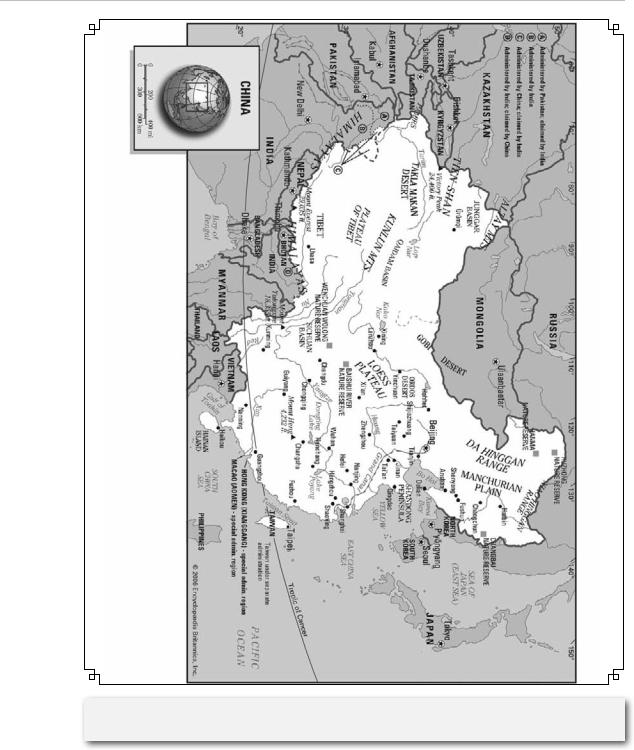
- •CONTENTS
- •INTRODUCTION
- •PREHISTORY
- •EARLY HUMANS
- •NEOLITHIC PERIOD
- •CLIMATE AND ENVIRONMENT
- •FOOD PRODUCTION
- •MAJOR CULTURES AND SITES
- •INCIPIENT NEOLITHIC
- •THE FIRST HISTORICAL DYNASTY: THE SHANG
- •THE SHANG DYNASTY
- •THE HISTORY OF THE ZHOU (1046–256 BC)
- •THE ZHOU FEUDAL SYSTEM
- •SOCIAL, POLITICAL, AND CULTURAL CHANGES
- •THE DECLINE OF FEUDALISM
- •THE RISE OF MONARCHY
- •ECONOMIC DEVELOPMENT
- •CULTURAL CHANGE
- •THE QIN EMPIRE (221–207 BC)
- •THE QIN STATE
- •STRUGGLE FOR POWER
- •THE EMPIRE
- •DYNASTIC AUTHORITY AND THE SUCCESSION OF EMPERORS
- •XI (WESTERN) HAN
- •DONG (EASTERN) HAN
- •THE ADMINISTRATION OF THE HAN EMPIRE
- •THE ARMED FORCES
- •THE PRACTICE OF GOVERNMENT
- •RELATIONS WITH OTHER PEOPLES
- •CULTURAL DEVELOPMENTS
- •THE DIVISION OF CHINA
- •DAOISM
- •BUDDHISM
- •THE SUI DYNASTY
- •INTEGRATION OF THE SOUTH
- •EARLY TANG (618–626)
- •ADMINISTRATION OF THE STATE
- •FISCAL AND LEGAL SYSTEM
- •THE PERIOD OF TANG POWER (626–755)
- •RISE OF THE EMPRESS WUHOU
- •PROSPERITY AND PROGRESS
- •MILITARY REORGANIZATION
- •LATE TANG (755–907)
- •PROVINCIAL SEPARATISM
- •CULTURAL DEVELOPMENTS
- •THE INFLUENCE OF BUDDHISM
- •TRENDS IN THE ARTS
- •SOCIAL CHANGE
- •DECLINE OF THE ARISTOCRACY
- •POPULATION MOVEMENTS
- •GROWTH OF THE ECONOMY
- •THE WUDAI (FIVE DYNASTIES)
- •THE SHIGUO (TEN KINGDOMS)
- •BARBARIAN DYNASTIES
- •THE TANGUT
- •THE KHITAN
- •THE JUCHEN
- •BEI (NORTHERN) SONG (960–1127)
- •UNIFICATION
- •CONSOLIDATION
- •REFORMS
- •DECLINE AND FALL
- •SURVIVAL AND CONSOLIDATION
- •RELATIONS WITH THE JUCHEN
- •THE COURT’S RELATIONS WITH THE BUREAUCRACY
- •THE CHIEF COUNCILLORS
- •THE BUREAUCRATIC STYLE
- •THE CLERICAL STAFF
- •SONG CULTURE
- •INVASION OF THE JIN STATE
- •INVASION OF THE SONG STATE
- •CHINA UNDER THE MONGOLS
- •YUAN CHINA AND THE WEST
- •THE END OF MONGOL RULE
- •POLITICAL HISTORY
- •THE DYNASTY’S FOUNDER
- •THE DYNASTIC SUCCESSION
- •LOCAL GOVERNMENT
- •CENTRAL GOVERNMENT
- •LATER INNOVATIONS
- •FOREIGN RELATIONS
- •ECONOMIC POLICY AND DEVELOPMENTS
- •POPULATION
- •AGRICULTURE
- •TAXATION
- •COINAGE
- •CULTURE
- •PHILOSOPHY AND RELIGION
- •FINE ARTS
- •LITERATURE AND SCHOLARSHIP
- •THE RISE OF THE MANCHU
- •THE QING EMPIRE
- •POLITICAL INSTITUTIONS
- •FOREIGN RELATIONS
- •ECONOMIC DEVELOPMENT
- •QING SOCIETY
- •SOCIAL ORGANIZATION
- •STATE AND SOCIETY
- •TRENDS IN THE EARLY QING
- •POPULAR UPRISING
- •THE TAIPING REBELLION
- •THE NIAN REBELLION
- •MUSLIM REBELLIONS
- •EFFECTS OF THE REBELLIONS
- •INDUSTRIALIZATION FOR “SELF-STRENGTHENING”
- •CHANGES IN OUTLYING AREAS
- •EAST TURKISTAN
- •TIBET AND NEPAL
- •MYANMAR (BURMA)
- •VIETNAM
- •JAPAN AND THE RYUKYU ISLANDS
- •REFORM AND UPHEAVAL
- •THE BOXER REBELLION
- •REFORMIST AND REVOLUTIONIST MOVEMENTS AT THE END OF THE DYNASTY
- •EARLY POWER STRUGGLES
- •CHINA IN WORLD WAR I
- •INTELLECTUAL MOVEMENTS
- •THE INTERWAR YEARS (1920–37)
- •REACTIONS TO WARLORDS AND FOREIGNERS
- •THE EARLY SINO-JAPANESE WAR
- •PHASE ONE
- •U.S. AID TO CHINA
- •NATIONALIST DETERIORATION
- •COMMUNIST GROWTH
- •EFFORTS TO PREVENT CIVIL WAR
- •CIVIL WAR (1945–49)
- •A RACE FOR TERRITORY
- •THE TIDE BEGINS TO SHIFT
- •COMMUNIST VICTORY
- •RECONSTRUCTION AND CONSOLIDATION, 1949–52
- •THE TRANSITION TO SOCIALISM, 1953–57
- •RURAL COLLECTIVIZATION
- •URBAN SOCIALIST CHANGES
- •POLITICAL DEVELOPMENTS
- •FOREIGN POLICY
- •NEW DIRECTIONS IN NATIONAL POLICY, 1958–61
- •READJUSTMENT AND REACTION, 1961–65
- •THE CULTURAL REVOLUTION, 1966–76
- •ATTACKS ON CULTURAL FIGURES
- •ATTACKS ON PARTY MEMBERS
- •SEIZURE OF POWER
- •SOCIAL CHANGES
- •STRUGGLE FOR THE PREMIERSHIP
- •CHINA AFTER THE DEATH OF MAO
- •DOMESTIC DEVELOPMENTS
- •INTERNATIONAL RELATIONS
- •RELATIONS WITH TAIWAN
- •CONCLUSION
- •GLOSSARY
- •FOR FURTHER READING
- •INDEX

22 | The History of China
A Chinese scientist holds the unearthed bones of a human who lived 25,000 years ago. AFP/ Getty Images
global political geography, and China has since come to rank among the most influential countries in the world.
PREhISTORy
Early Humans
The fossil record in China promises fundamental contributions to the understanding of human origins. There is considerable evidence of Homo erectus by the time of the Lower Paleolithic (the
Paleolithic Period [Old Stone Age] began about 2,500,000 years ago and ended 10,000 years ago) at sites such as Lantian, Shaanxi; Hexian, Anhui; Yuanmou, Yunnan; and, the most famous, that of Peking man at Zhoukoudian, Beijing municipality. The Lower Cave at Zhoukoudian has yielded evidence of intermittent human use from about 460,000 to 230,000 years ago, and fossils of Peking man found in the complex have been dated to about 770,000 years ago. Many caves and other sites in

The Beginnings of Chinese History | 23
This map shows China and its special administrative regions.

24 | The History of China
Anhui, Hebei, Henan, Liaoning, Shandong, Shanxi and Shaanxi in northern China and in Guizhou and Hubei in the south suggest that H. erectus achieved wide distribution in China. Whether H. erectus pekinensis intentionally used fire and practiced ritual cannibalism are matters under debate.
Significant Homo sapiens cranial and dental fragments have been found together with Middle Paleolithic artifacts. Such assemblages have been unearthed at Dingcun, Shanxi; Changyang, Hubei; Dali, Shaanxi; Xujiayao, Shanxi; and Maba, Guangdong. Morphological characteristics such as the shovel-shaped incisor, broad nose, and mandibular torus link these remains to modern Asians. Few archaeological sites have been identified in the south.
A number of widely distributed H. erectus sites dating from the early Pleistocene Epoch (i.e., about 1.8 million years ago) manifest considerable regional and temporal diversity. Upper Paleolithic sites are numerous in northern China. Thousands of stone artifacts, most of them small (called microliths), have been found, for example, at Xiaonanhai, near Anyang, at Shuoxian and Qinshui (Shanxi), and at Yangyuan (Hebei); these findings suggest an extensive microlith culture in northern China. Hematite, a common iron oxide ore used for colouring, was found scattered around skeletal remains in the Upper Cave at Zhoukoudian (c. 10th millennium BC) and may represent the first sign of human ritual.
Neolithic Period
The complex of developments in stone tool technology, food production and storage, and social organization that is often characterized as the “Neolithic Revolution” was in progress in China by at least the 6th millennium BC. Developments during the Chinese Neolithic Period (New Stone Age) were to establish some of the major cultural dimensions of the subsequent Bronze Age.
Climate and Environment
Although the precise nature of the paleoenvironment is still in dispute, temperatures in Neolithic China were probably some 4 to 7 °F (2 to 4 °C) warmer than they are today. Precipitation, although more abundant, may have been declining in quantity. The Qin (Tsinling) Mountains in north-central China separated the two phytogeographical zones of northern and southern China, while the absence of such a mountain barrier farther east encouraged a more uniform environment and the freer movement of Neolithic peoples about the North China Plain. East China, particularly toward the south, may have been covered with thick vegetation, some deciduous forest, and scattered marsh. The Loess Plateau north and west of the Qin Mountains is thought to have been drier and even semiarid, with some coniferous forest growing on the hills and with brush and open woodland in the valleys.

The Beginnings of Chinese History | 25
A farmer in Shaoshan, Hunan province, China, gathers bundles of dried millet stalks. Frederic J. Brown/AFP/Getty Images
food Production
The primary Neolithic crops, domesticated by the 5th millennium BC, were drought-resistant millet (usually Setaria italica), grown on the eolian and alluvial loess soils of the northwest and the north, and glutenous rice (Oryza sativa), grown in the wetlands of the southeast. These staples were supplemented by a variety of fruits, nuts, legumes, vegetables, and aquatic plants. The main sources of animal protein were pigs, dogs, fish, and
shellfish. By the Bronze Age, millet, rice, soybeans, tea, mulberries, hemp, and lacquer had become characteristic Chinese crops. That most if not all of these plants were native to China indicates the degree to which Neolithic culture developed indigenously. The distinctive cereal, fruit, and vegetable complexes of the northern and southern zones in Neolithic and early historic times suggest, however, that at least two independent traditions of plant domestication may have been present.
